Ecotrackers documental sobre su trabajo con las nacionalidad de los Cayambis y Otavalos
Este es un blog para contar el trabajo de los voluntarios de Ecotrackers en la Reserva Cayambe Coca. La Chimba es una comunidad situada en el norte de los Andes, en esta reserva en la que hay páramos y el nevado. (This blog is to record the volunteer work of Ecotrackers in the Cayambe Coca Reserve. La Chimba is a community situated in the Andes, and in this reserve there are paramos and snowfall.)
Este es un blog para contar el trabajo de los voluntarios de Ecotrackers en la Reserva Cayambe Coca. La Chimba es nuestra primera comunidad en la zona y es una comunidad situada en el norte de los Andes del Ecuador, en esta reserva en la que hay páramos y el nevado Cayambe 5780 msnm y las cultuas indigenas de los Cayambis, Caranquis, Quichuas y Alamas

Hoja de contacto comunitario – Fundación Ecotrackers E.mail: .ecotrackers@gmail.com
| COMUNIDAD | | ||||||
| Director Local | Vinico Quilo | ||||||
| telefono |
| ||||||
| Dirección | Tomar un bus en Otavalo y llegar al Parque Central de Cayambe y preguntar por la estacion de buses a | ||||||
| Nombre del voluntario |
| ||||||
| Número de contrato |
| ||||||
| Nivel de español | Excelenete cumpleaños 27 de Oct | ||||||
| E.mail del voluntario | | ||||||
| Pago en Ecotrackers | Por Registración: Por No. de días:5=10 Total: 10 | ||||||
| Fecha del trabajo | 4 Abril al 27 de Abril 2007 | ||||||
| PLAN DE ACTIVIDADES Y RESULTADOS ESPERADOS | ANTECEDENTES: Desde desde el año 2003 Ecotrackers trabaja con Vinicio Quilo para desarrollar el trabajo de la organización Condor Huasi. Actualmente Vinicio es un dirigente de la comunidad y además está trabjando con otras comunidades. En la comuidad esta reacondicionando mediante mingas (trabajos colectivos) la casa de Hacienda del que fue presidente del Ecuador Galo Plaza, para hacer un lugar de atención a turistas y un centro de entrenamiento en ecoturismo comunitario. Este entrenamiento incluye la capacitacion de los miembros de Condor Huasi en otros lugares de trabajo de Ecotrackers en una relación reciproca con los directores y miembros de otras comunidades que les van a raecibir ACTIVIDAD1.- Dar clases de ingles a los niños de deportes e ingles ACTIVIDAD 2.- Explorar el páramo, las huertas indigenas y claborar e la reparación de la casa de hacienda. ACTIVIDAD3.- Recopilar formación sobre lo que fue el desarrollo en la zona RESULTADOS Evaluación de los procesos de desarrollo, las alternativas ante las amenazas | ||||||
| Lugar de publicación | |||||||
| Pago a la comunidad | Valor por comida, acomodación y guía: $8x 5 días= $45 | ||||||
| Persona que recibe el $ | Nombre: Vinicio Quito firma: | ||||||
| CONTACTOS PRELIMINARES | 31 de Marzo 2007 | ||||||
| PRECAUCIONES | Observaciones: ropa para el frío | ||||||
| | | | |||||
| En emergencia | Telfs:085561622/ 02-2550208/02-2544074 (night)/098741081(JC) | ||||||
La Chimba also named Yacuchimba is a comunity which
spreads at about 3100 m on the north pastures of
the Nevado Cayambe, the third ecuadorian summit.
(5790m). About 360 families live there. It is the last
place before the national park of Cayambe-coca. This
reserve is known for is high biodiversity with a large
scale of altitude, from the tropical forests to the eternal
snows of the Nevado. La Chimba is a great place to
discover the rural side of Ecuador. You can have a walk
to reach the Laguna San Marcos, you can help to dairy
cows, or you can just sit down and talk with people.
At 3300m high
La Chimba es también llamada Yacuchimba. Es una comunidad que
Se extiende aproximadamente a 3100 m del páramo ubicado al norte del Nevado Cayambe, la tercera cumbre más alta del Ecuador. (5790msnm) Cerca de 360 familias viven allí, es la última población antes de llegar al parque nacional de la Cayambe-Coca. Se sabe que la reserva para es de una alta biodiversidad, debida a la fuerte variación
de la altitud; de los bosques tropicales a las eternas
nieves del Nevado. La Chimba es un sitio maravilloso para descubrir el lado rural de Ecuador. Usted podría hacer una caminata
y alcanzar el Laguna San Marcos, o también ayudar a ordeñar a
las vacas, o podría sentarse en la comunidad y hablar con la gente.
A los 3300m de altitud.
Los Chimbaños take their origin from
the Kayambi etnic which spread in the
Cayambe district. The country use to
be occupied by the conquistadors who
treated them as slaves. The Chimbaños own their territory
since 1971. Each family farms very small plots (about 6,5
ha). Bovine milk production is today the main activity of
the community. They also grow vegetal crop and cheep
flocks for meat. In order to diversify the resssources,
young members created Condor Huasi. Since 2003,
this association permit to you to enter in the life of the
community and to live as an habitant. Condor Huasi also
have a folkloric group which displays traditional dances
and musics on celebrates and on tours.
Los Chimbaños se originan de
el Kayambi etnia que se separó en
Departamento de Cayambe. Debido a la conveniencia de los conquistadores que ocuparon país, mientras trataban a los indígenas como menos que esclavos. Los Chimbaños son dueños de su territorio
desde 1971. Cada familia cultiva en parcelas muy pequeñas (cerca de 6.5
ha). La producción de leche de vacas es hoy la actividad principal de
la comunidad. También practican la agricultura y pian
ocks de la Florida para la carne. Para diversificar los recursos,
los miembros jóvenes crearon el Condor Huasi. Desde 2003,
con el permiso de la asociación usted puede conocer la vida de la
comunidad y vivir como un nativo. Condor Huasi también
tiene un grupo folklórico que exhibe danzas tradicionales
y tocan su música en celebraciones y viajes.
COMMUNITY BASED ECOTOURISM
UNIQUE EXPERIENCE IN THE ANDIN LANDSCAPE
After two weeks
teaching english in
La Chimba, it was
the people, with their
generosity, kindness
and deep connection
to their culture that I
will remember best.
-Nick.f
USA
La EXTRAORDINARIA EXPERIENCIA EN EL PAISAJE ANDINO
Después de dos semanas de enseñar inglés en La Chimba,
serán las personas, con su generosidad, su bondad y su conexión profunda a su cultura lo que recordaré mejor.
-Nick.F
EEUU
Visiting La Chimba means a
real help and a cultural trade.
By sharing moments with
indeginous people, you will
better understand their way
of life and in the same time
contribute to their global
development (education,
ressources managment, life
conditions and cultural indentity)
Visitar La Chimba significa una verdadera ayuda y un comercio cultural. Compartiendo momentos con personas
indígenas, usted entenderá mejor su estilo de vida y en al mismo tiempo contribuirá a su desarrollo integral
(la educación, administración de recursos, las condiciones de la vida e identidad cultural)
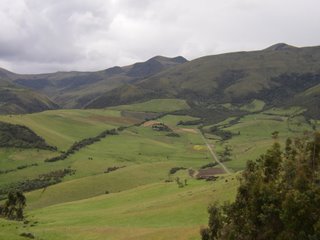


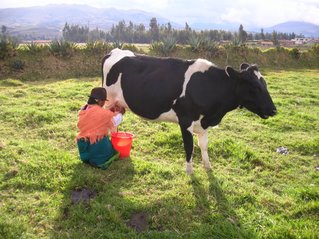
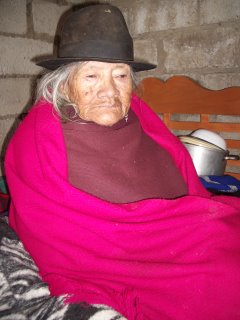
PROYECTO DE DESARROLLO DEL CENTRO DE CAPACITACION EN TURISMO COMUNITARIO DE
ANTECEDENTES:
Desde el año 2003 Ecotrackers trabaja con
Desde fines del 2004 el número de voluntarios aumentó por el trabajo de Andy Kirby que consolidó relaciones con proveedores internacionales de voluntarios como nuestro director de proyectos, pero a raíz de la crisis, en que los voluntarios extranjeros de largo plazo en Quito, restaron funciones a todos los fundadores y cuerpo directivo de Ecotrackers y concluyó con la salida de los extranjeros de administración de Ecotrackers, se puso difícil el trabajo con la Chimba
Lo curioso fue que la comunidad vino a visitarnos. Les pregunté su posición respecto a la relación con Ecotrackers, sabiendo que nuestro ex director de proyectos, había hecho otra fundación copiando todo de nosotros y que considerábamos que había habido un robo de propiedad intelectual, a lo que nos contestaron que estaban con Ecotrackers
Es indudable tenemos un lado flaco y es que si no enviamos suficientes voluntarios ellos se irán con el mejor postor, pues tienen que resolver problemas económicos que los presiona.
Para continuar les propuese que el turismo comunitario como estaba planteado era una forma de humillación, en la que lo mejor de nosotros era para cualquiera de los extranjeros, pero lo mejor de ellos no era para cualquiera de nosotros. Nuestros voluntarios sólo habías servido en estos últimos tiempos para preparar a la comunidad para ser servidores mal pagados, que ha sido nuestra triste historia por 500 años.
Se hacía necesario cambiar, pensar que lo que teníamos no era sólo para extranjeros, que debía ser también para ecuatorianos, pero sobre todo para otros indígenas como ellos, que estuvieran interesados. El turismo comunitario que ahora tenemos y es aceptado por el Ministerio de Turismo, es aquel en que las comunidades desarrollaban una infraestructura y una serie de servicios que hacen felices a otros, a costa de la propia felicidad y por dinero. Un turismo en que el visitante siempre tiene la razón a pesar de que no sea correcto, sabio, honesto lo que pidan y sobre todo sea un buen negocio para los intermediarios que nos traen voluntarios o turistas.
El turismo inteligente por el contrario ofrecía la posibilidad de entender la naturaleza, a nuestra gente, a las culturas, la agricultura, la medicina tradicional etc, a personas con mas talento y capacidad de adaptación, que podían contribuir con uno pocos dólares mas sus estudios y trabajo, con la premisa, de que ellos deberán llegar solos y sin intermediarios. Algo todavía muy difícil pero que se irá dando en la medida que el internet se afianse como un medio para evitar los intermediarios en todas las transacciones.
Para esto había que además hacer un centro de estudios donde los profesores fueran la mejor gente de ustedes mismos. Estos profesores enseñarían a indígenas, mestizos ecuatoriano y extranjeros las artesanías, las artes, la comida tradicional, la guianza en el páramo, la valoración de la historia, los procesos organizativos. Para esto no necesitamos gente de afuera, se trata de escoger a los mejores de los nuestros y darles las condiones para que puedan transmitir sus conocimientos y experiencias, cuidándonos siempre de que nuestra información les sirva a los visitantaes para hacer un gran negocio, o para mantenernos en las condiciones de explotación que ahora vivimos.
Este instituto sería el verdadero ingreso para la comunidad en lugar del hotel que se estaba pensando hacer en la vieja casa de la hacienda, hacer aulas talleres . Sin duda, era posible hacer también una residencia para los estudiantes y un restaurante que servirían como lugares de práctica.
La idea fue consultada a la comunidad que se mostró interesada, pues esto habría esperanzas para todos, el turismo hasta el momento era beneficioso para unos pocos. La segunda reunión fue para tratar como se podía legalizar el centro de capacitación.
Les propuse que Ecotrackers podía reconocer un certificado a los estudiantes que cumplieran 120 horas en cada uno de los talleres que hiciéramos. Este título estaría avalizado por el ministerio de Educación, como un mecanismo para empezar.
Una segunda opcion es que el CODEMPE o
LOS RECUROS DE
La comunidad construyó con la ayuda del Ministerio del Ambiente una casa para centro de información y restaurante a la entrada de
La comunidad cuenta ahora con la casa de Hacienda en la que se están haciendo las adecuaciones para un hotel restaurante.
Nuestra recomendación es que sea solo para un restaurante, y para un centro de interpretación del ecosistema Cayambe-Coca y capacitación en ecoturismo comunitario indígena.
En la comunidad hay una organización de mujeres que ha recibido ayuda del PNUD de las Naciones Unidas en su programa de pequeñas donaciones que ya fabrica mermeladas y otros productos.
También tiene una organización de agricultores que ha recibido dinero por medio de una fundación para desarrollar el riego.
Cuenta con músicos y danzantes.
Tiene buenas cocineras de comida tradicional
Ha formado sus guías locales que incluso ya tienen reconocimiento del Ministerio de Turismo.
No tiene un buen Chaman
No hablan el Quechua pero cuentan con un profesor de quechua.
Tiene personas con experiencia en la preparación, presentación y negociación de proyectos.
Tienen personas familiarizadas con la preparación de fiestas y eventos populares
Cuentan con caballos.-
No cuentan con buenas bicicletas.
LO QUE EL PUEBLO NECESITA
Terminar la reconstrucción de la casa de Hacienda
Desarrollar un programa de estudios.
Registrar el programa de estudios para su aprobación por el Ministerio de Educación
o el Codempe
Reforestar sus calles y construir jardines.
Construir parques y lugares llamativos en las montañas próximas
Destacar el lugar donde se encuentra una litografía y usar ese lugar para un museo de Sito.
Terminar su centro de información de su memoria histórica y biológica en el puesto de ingreso a
Hacer una carpeta con los mejores lugares para aflojamientos doméstico y camping.
Publicar el Tríptico y hacer pósteres con los materiales producidos por los voluntarios de Ecotrackers
Hacer su página Web
Hacer un calendario de experiencias en trabajo agrícolas
Hacer su calendario de fiestas y eventos culturales
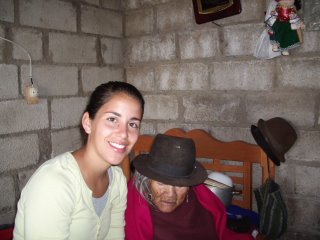
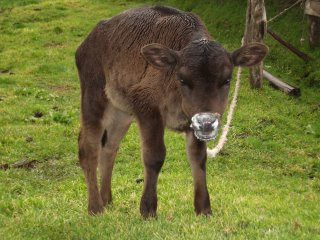
| Written by Graham Montague | |||
I went with another volunteer and we first caught a bus to Cayambe which is about an hour and a half by bus from Quito. The journey from Cayambe to La Chimba takes an hour by bus along a rough road that is basically a dirt track in places and paved with cobble stones in others. I am told that the buses have to have their suspensions changed every six months! The bus we caught from Cayambe was packed, with a lot of people standing. On the way we passed many small communities along the way and eventually arrived in La Chimba. We arrived around midday on a Saturday. When we arrived there was a crowd of people laying turf on what is the village football pitch. Apparently it had been a dirt pitch with a large slope and they have now levelled it and are making it into a grass pitch, a task that will take a few months to complete. There seems to be a regular morning work party, many of whom are women. The other volunteer had bought a football on the way and we were soon playing in the street with a couple of children who greeted us enthusiastically. In fact, one of them, Morella (?), is absolutely charming. She is nine years old but has an engaging manner way beyond her years. Perhaps she should be given the job of welcoming visitors to the village. La Chimba is at an altitude of about 8,000ft(?) and is set in a long broad valley surrounded by mountains. It is a community of about 400 families. The village has one long street with several short side streets off it. In some ways it is a bit like a Wild West town, especially when one of the local caballeros rides along it. Many people seem to have horses and they all look well cared for. The quite elaborate tack is very impressive, especially the decorative traces and the stirrups with built in clogs - I'm not a horseman, so this is not very technical! The community revolves around dairy production with many people milking befoer dawn and then again at 4.00pm in the afternoon. Because of the early start, people seem to go to bed early. The cows are often some way from where people live and people either walk to their fields or catch the bus. There are no stalls to milk the cows in, they are milked out in the open with their legs tied together to encourage them to keep still. There is an informal network of lifts for collecting people with their milk and taking them with their containers back to the communal dairy centre. The churns can be heavy but many of the milkers are women of considerable age. They scoop the churns up in a shawl and carry them on their backs. I made hard work of carrying one churn a short distance and over a somewhat rickety wooden bridge. I had a go at milking but managed to spook the cow who trotted off before being made to settled down again. The climate is such that the growing season is all year round. They don't have to cut and store food for animals. All around the village are patches of rough land where an assortment of animals, including chickens, pigs and sheep, can be found grazing. Sometimes they are tethered, sometimes hobbled (feet tied together with a short rope), and sometimes just loose. Unfortunately, there is a lot of rubbish lying around and this somewhat spoils the bucolic setting. Whilst the village itself can be dry and dusty, the surrounding fields and mountains present a vast patchwork of green, partly cultivated land and partly natural vegetation. Many of the older women wear traditional clothes with bright skirts and shawls, several layers of bright beads round their necks and a sort of 'pork pie' hat. They often seem to wear quite flimsy shoes but the standard footwear is wellingtons. While I was at La Chimba I went on two outings. The first was to a hot spring high up in the mountains. A small group of us was taken in a pick-up to a point from where we walked up and down through long grass until we came to the thermal pool. There is a small hut for changing in if you want a little privacy. I chose to change, hopping from foot to foot, on the rocks by the pool. It was a strange but exhilarating experience stripping off and lying in the warm water looking out over a green valley towards mountains beyond. The second outing was to San Marco lake, again a pick-up ride into the mountains. There is a feeling of such space and openness, winding your way upwards with mountains all around. That morning was very clear and all along the way we could see the snow capped Nevada Cayambe outlined against the clear blue sky. It is a very hypnotic presence and it keeps drawing your eyes back to it. The San Marco lake itself is not spectacular but its setting is. On this outing we had a ride across a river in a metal cradle on a pulley, which gave us a great feeling of adventure. I had been learning Spanish for only a few weeks and so my language skills were quite limited. I was lucky that there were other volunteers who spoke better Spanish. None of the community seemed to speak any English which is likely to be a bit of a barrier to communicating with visitors. It was discussed that I might start to teach the guides some English but this did not happen - only partly because I was not feeling as well as I would have liked and left La Chimba earlier than planned. Motivation to learn some English might need to be encouraged and a programme agreed with the community. The house where I stayed was modest, which is to be expected, but it was also very dirty and, in my opinion, not acceptable to paying visitors. Another volunteer stayed in what seemed to be a simple but better looked after home. I think it it is important for the community to ensure that host homes are of a minimum standard and suitable for visitors. The community is wanting to attract visitors for short stays. People in the community are friendly and happy to involve you in their lives. Some are interested to ask questions about where you come from. Apart from asking you about your family, one common question is how much your currency is worth! La Chimba is well worth a visit to see how its people go about their modest everyday lives and for you to enjoy and appreciate its beautiful setting. | |||
| [ Back ] | |||
| La Chimba | | | |